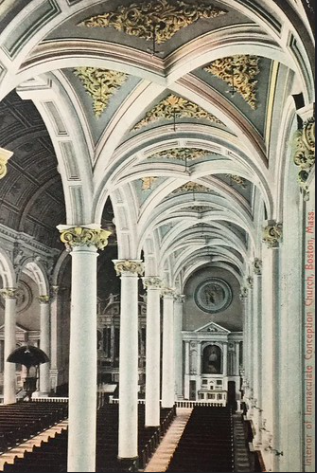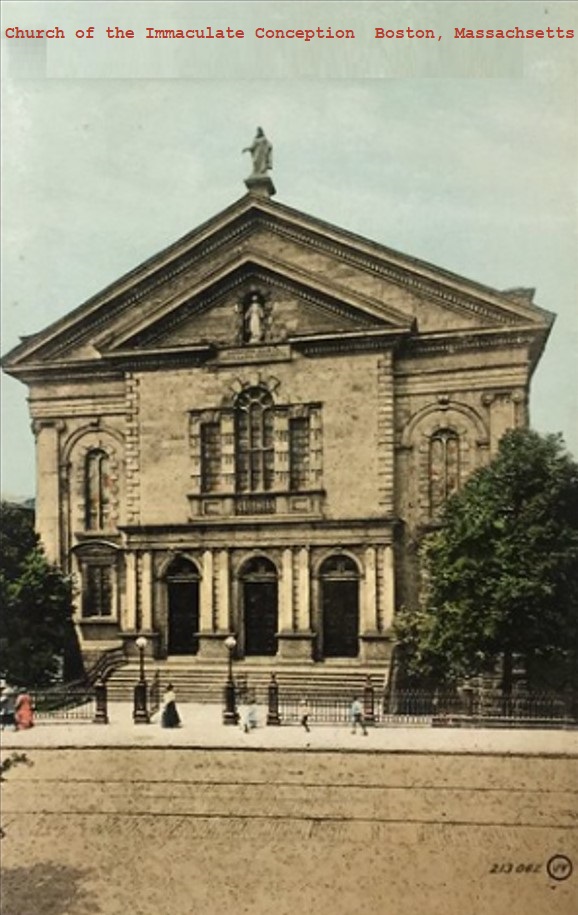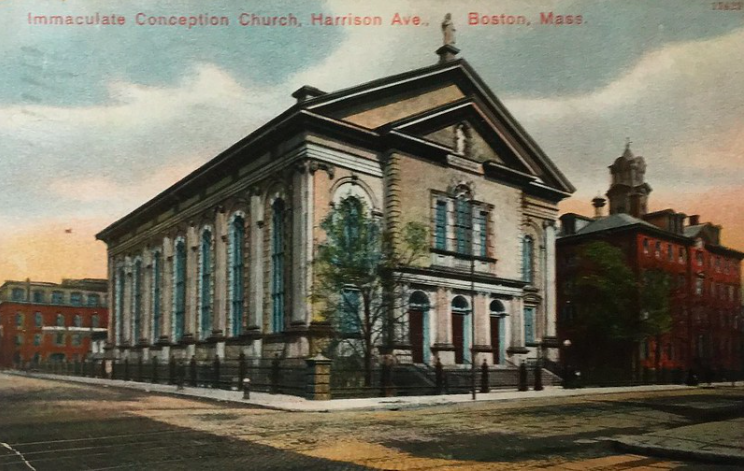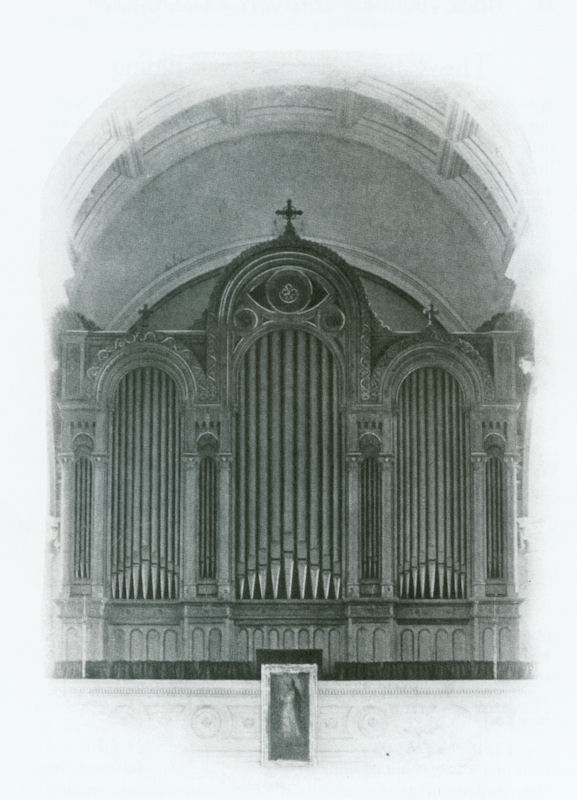Immaculate Conception Roman Catholic Church
Harrison Avenue
Boston, MA
Note: Not extant. Not playable. (in this location)
Images
 Before 1930 - Interior side aisle detail (Photograph from an archival source: Archdiocese of Boston Archives, submitted by Andrew Scanlon/Andrew Scanlon)
Before 1930 - Interior side aisle detail (Photograph from an archival source: Archdiocese of Boston Archives, submitted by Andrew Scanlon/Andrew Scanlon) Before 1930 - Exterior (Photograph from an archival source: Historic postcard, Archdiocese of Boston Archives, submitted by Andrew Scanlon/Andrew Scanlon)
Before 1930 - Exterior (Photograph from an archival source: Historic postcard, Archdiocese of Boston Archives, submitted by Andrew Scanlon/Andrew Scanlon) Before 1930 - Exterior (Photograph from an archival source: Vintage postcard, Archdiocese of Boston Archives, submitted by Andrew Scanlon/Andrew Scanlon)
Before 1930 - Exterior (Photograph from an archival source: Vintage postcard, Archdiocese of Boston Archives, submitted by Andrew Scanlon/Andrew Scanlon) Before 1930 - Interior (Photograph from an archival source: Vintage postcard, Archdiocese of Boston Archives, submitted by Andrew Scanlon/Andrew Scanlon)
Before 1930 - Interior (Photograph from an archival source: Vintage postcard, Archdiocese of Boston Archives, submitted by Andrew Scanlon/Andrew Scanlon) before 1902 - Illustration of organ case and facade (Photograph from an archival source: Hook Organs, published by OHS Press, submitted by Jim Stettner/Jim Stettner)
before 1902 - Illustration of organ case and facade (Photograph from an archival source: Hook Organs, published by OHS Press, submitted by Jim Stettner/Jim Stettner)
Consoles
Main
- 3 manuals
- 47 stops
- Key action Type: Mechanical (Details Unknown)
- Stop action Type: Mechanical
Notes
2004-10-30 - Rebuilt and electrified by Hook & Hastings in 1902 as Op. 1959, (4-47). -Database Manager
2005-11-04 - Updated through online information from Sean O'Donnell. -Database Manager
2021-08-01 - The case, designed by the builder of the church, Patrick Keeley, was not built by the Hooks, but by a separate firm. Typical for non-organbuilder constructed cases, the case was nailed, where builders would always construct their cases with screws. The facades pipes were in a tin-colored leaf, likely Palladian leaf with black ornamentation about the mouths. This can be seen in historic stereo slides of the interior. The pipes were redecorated with an opaque gold glaze. The Great action and its couplers were fitted with a Barker machine assist- likely the first for Hook, and the console, typical for large Catholic churches, was detached and reversed so the organist faced the altar. The organ had two pressures, 3" for the manuals, 3 1/2" for the Barker machine and Pedal division. The organ was built during a period of adversity for the Hook firm, with almost the entirety of the staff away at War, and the remaining group, probably about 15 or so older men, disabled, or immigrants managed to construct this monumental organ at a time that there were constant material shortages.
The Swell had a double set of shades operated by a hitchdown pedal, and like the Cathedral of Holy Cross built a decade later, was so heavy it practically required the organist to stand on the pedal to open it. The famous organist John Willcox was the church's organist at the time of the organ's opening. He had worked with the Hooks on and off as an advisor on tonal affairs, and the forward-looking disposition of this major work bears the stamp of his input, employing a wide variety of color and pipe forms, with a sophisticated terracing of dynamics between the various stops.
From the outset, the organ was unexpectedly mild in the spacious acoustic of the church, possibly partly due to the density of the facade. This was addressed in the 1902 rebuild with the addition of the high-pressure Solo and scale enlargement of the main Great Diapason. At some point before 1902, the Pedal was enlarged with the needed addition of the Bourdon 32' and stopped Flute 8'. Each of the three manual chests had been prepared with an empty slider, and that of the Choir at least was intended for a Mixture. Just seven years after the organ was opened, the large and unusual Cymbale was installed on the Great, but by William Johnson of Westfield. This would have been a major slap in the face to the Hooks for whom this was a major commission in the city of Boston and whose shop was practically around the corner. The story behind this is lost to us, but surely involved some kind of intrigue. The city of Boston is unique in having large Cymbales on three of its most important 19th-century instruments: Immaculate, Holy Cross, and Mission Church, and while the function of each was surely intended to be similar, the composition of each was different. While the Great Stopt Diapason would not have been unusual in a stoplist of this era, we know this stop was actually a Doppel Flute--introduced this same year in the Walcker installed in the Boston Music Hall and obviously a last-minute upgrade. Unfortunately, this was replaced in 1902 with the Mezzo Diapason. -Scot Huntington
Stoplist
Specification from <i>The Organ in New England</i> by Barbara Owen (Raleigh: The Sunbury Press, 1979) Source: Source not recorded Date not recorded
Boston, Massachusetts
Immaculate Conception Catholic Church
E. & G.G. Hook Opus 322 1863 3 manuals, 45 stops, 55 ranks
____________________________________________________________________________
Source: "Dwight's Journal of Music" (Mar 5, 1864), and examination of organ.
GREAT ORGAN SWELL ORGAN
16' Open Diapason 58 16' Bourdon Bass 12
8' Open Diapason 58 16' Bourdon Treble (TC) 46
8' Claribella 58 8' Open Diapason 58
8' Stop'd Diapason * 58 8' Stop'd Diapason 58
8' Viola da Gamba 58 8' Violina 58
4' Octave 58 4' Octave 58
4' Flute Harmonique 58 4' Flute Harmonique 58
2 2/3' Twelfth 58 4' Octave Viol d'Amour 58
2' Fifteenth 58 2 2/3' Twelfth 58
2' Mixture III 174 2' Fifteenth 58
1 1/3' Mixture V 290 1 3/5' Mixture V 290
16' Trumpet [t.c] 46 16' Fagotto [t.c.] 44
8' Trumpet 58 8' Cornopean 58
4' Clarion 58 8' Oboe 58
8' Vox Humana 58
CHOIR ORGAN 4' Clarion 58
16' Bourdon Bass 12
16' Æolina (TC) 46 PEDAL ORGAN
8' Open Diapason 58 16' Open Diapason 27
8' Dulciana 58 16' Dulciana 27
8' Keraulaphon 58 10 2/3' Quint 27
8' Stop'd Diapason 58 8' Violoncello 27
8' Melodia 58 16' Trombone 27
4' Octave 58
4' Celestina 58
4' Flauto Traverso * 58
2' Picolo [sic] 58
8' Clarionet 58
* actually a Doppel Flute COUPLERS
Great and Swell
MECHANICALS Great and Choir
Tremulant for Swell Manual Choir and Swell
Tremulant for Choir Manual Pedal and Great
Ventil: Pedal 16' Open Diapason Pedal and Swell
Ventil: Pedal 10 2/3' Quint Pedal and Choir
& 16' Trombone Pedal at Octaves
[Received from Steven E. Lawson 2015-01-02]
Websites
Related Pipe Organ Database Entries
Other Links
Regrettably, it is not possible to display the information about the sponsor of this pipeorgandatabase entry or if there is a sponsor. Please see About Sponsors on Pipe Organ Database.




